ABS and PLA materials are the protagonists of 3D printing, almost occupying the sight of most engineers, but water soluble filaments are usually not paid too much attention. In fact, it also silently changes the support structure with its unique dissolution characteristics. This article will take you to explore this niche but key field in depth, and analyze it from the types and usage skills of water-soluble materials.
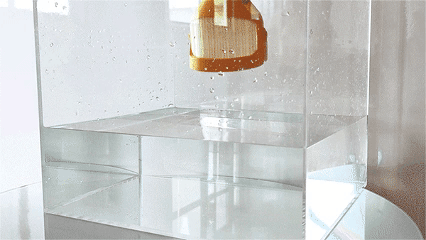
What is water soluble filament?
Water-soluble filament is a 3D printing material that can melt in water. People use it to print the support structure of the model. When you print the spiral hollow structure, the whole model is soaked in 40℃ water. Those supports as precise as spider webs will automatically disappear within 6 hours, and the surface finish will be improved by 300% compared with manual processing!
At present, the mainstream water-soluble filaments are PVA, BVOH and HIPS. PVA needs to be soaked in warm water for several hours to melt, but it is suitable for use with common PLA materials. BVOH melts faster in cold water and can be cleaned in two hours, but the price is more expensive than PVA. Both materials are afraid of moisture and should be stored in sealed bags at ordinary times. HIPS material cannot be melted directly with water and requires special chemical solvents.
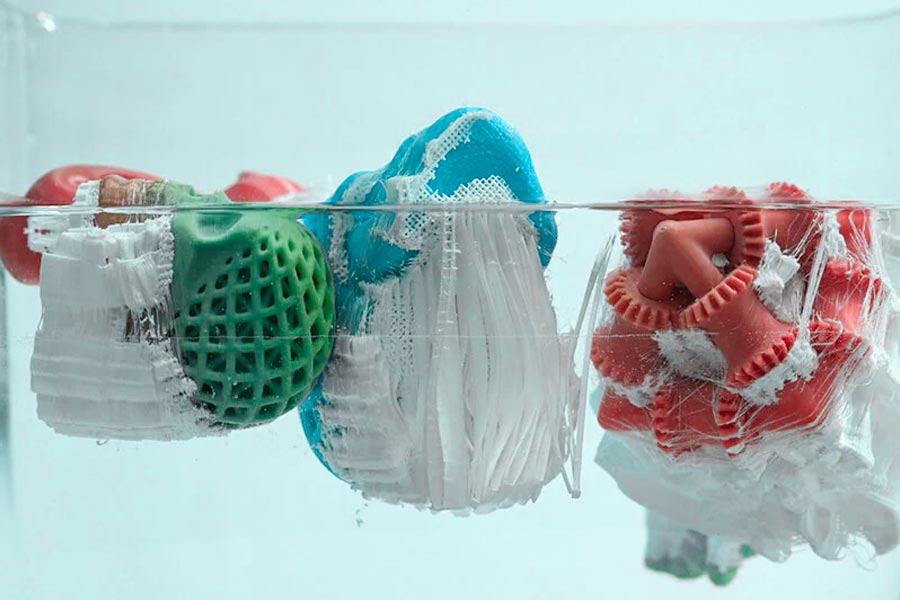
What are common water soluble filament types?
1.PVA material
PVA material is a representative type of water soluble filament material. It can be dissolved in water at room temperature, but it needs to be soaked for 4-8 hours. The nozzle temperature needs to be stable between 190℃-220℃ during printing. It is sensitive to air humidity and is easily damp and deteriorated when the humidity exceeds 30%. It needs to be avoided from long-term storage in a humid environment. PVA material is suitable for making support structures for complex models with PLA material.
2.BVOH material
BVOH is more durable than PVA. It can be dissolved in cold water at 20℃ for no more than 2 hours, and its moisture resistance is more than 50% higher than that of PVA. The printing temperature is higher (210-230℃), which is suitable for models that need to be resistant to high temperatures. At the same time, the printing temperature should not be lower than 210℃, which is easy to block the nozzle.
3.HIPS materials
HIPS material belongs to solvent based support materials. If you want to use water soluble materials to print ABS, it is the best choice, and it must be dissolved using D-limonene. We soak the model in solvent for 30-60 minutes, wait for the support structure to completely soften, and then remove and clean it.
This material requires a high printing temperature, and the nozzle needs to maintain a working temperature of 240℃-260℃. Suitable for making large models or structures that require high-strength support. Wear protective gloves during operation, and handle solvents in a well ventilated environment.
Technical parameters comparison table
| Characteristic | PVA | BVOH | HIPS |
| Dissolving medium | Normal temperature water | Cold water | D-limonene |
| Dissolution time | 4-8h | ≤2h | 0.5-1h |
| Printing temperature | 190-220℃ | 210-230℃ | 240-260℃ |
| Applicable main materials | PLA class | General use | ABS |
Safety tips:
When you use HIPS (a water soluble material), D-limonene solvent is volatile and air circulation must be ensured in the operating environment. It is recommended to equip a gas mask and corrosion-resistant gloves. Waste liquid should be recycled according to chemical treatment standards and is prohibited from being directly discharged into the sewer system.
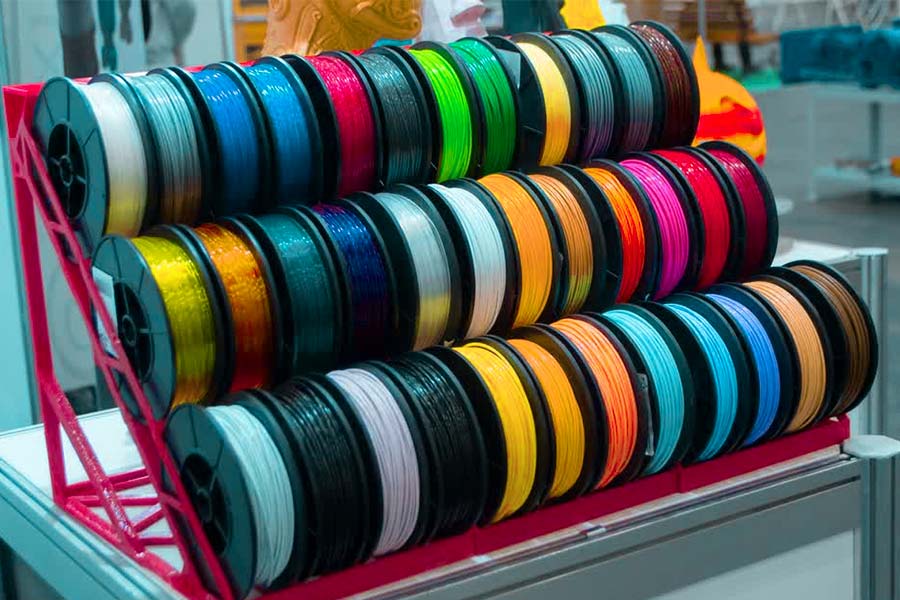
Why use water-soluble supports in complex 3D prints?
1.Geometric adaptability
Water soluble scaffolds automatically create tree like support structures through software plugins such as Cura and Fillamentum. This structure can tightly adhere to the surface of complex models.
- Addressing the issue of extreme overhang: For parts with overhang angles less than 15 degrees (such as turbine blade surfaces), brackets can prevent material sagging or breakage during printing.
- Intelligent gap filling: At the gear bite or branch of the vascular model, the bracket automatically fills the small gaps that traditional support cannot reach.
- Case application: LS successfully achieved a 0.2mm precision mesh cooling channel structure using a water-soluble bracket in the prototype printing of a certain aerospace component.
2.Surface refinement improvement
The roughness value of the contact surface between the water-soluble bracket and the model can be controlled within 3.2 microns, which is more than twice as smooth as traditional supports.
- Contact surface optimization: After the bracket dissolves, only slight traces are left on the surface of the model. Wipe with a damp cloth to achieve a smoothness that can be directly painted.
- Breakthrough in the medical field: In a certain artificial ear printing project, the cartilage structure surface supported by a water-soluble scaffold can be directly used for silicone flipping without the need for secondary polishing.
Data comparison:
After the traditional support is removed, there are burrs on the surface (roughness ≥ 6.3 μm).
After dismantling the water-soluble bracket, it approaches the original printing surface (roughness ≤ 3.2 μm).
3. Comprehensive efficiency upgrade
After adopting water-soluble support, users can reduce post-processing time by more than 70%. This is particularly evident for models with internal structures.
Time cost comparison:
| Production processes | Traditional support takes time | Water soluble stent time-consuming |
| Remove support | 45 minutes/piece | Soak for 5 minutes |
| Surface Treatment | 30 minute polishing | Wipe for 2 minutes |
Special structural applications:
- Automotive oil circuit model: After dissolving the bracket, the bent pipe with an inner diameter of 0.8mm is fully retained.
- Prototype of mechanical watch: 32 nested gear sets can be fully removed at once.
- Labor cost reduction: According to LS' batch production project data, the use of water-soluble brackets has reduced the single piece labor cost from $8.7 to $2.1.
Specific improvement methods for LS operation process
Prototype production process of drone propeller:
- Traditional way:
Manually dismantling the support resulted in deformation of three propeller blades.
It takes 2 hours to repair the surface.
The final scrap rate is 25%. - Water soluble support scheme:
Soak in 60 ℃ warm water for 90 minutes and automatically separate.
Cotton swab cleaning takes 5 minutes to meet assembly requirements.
The scrap rate has dropped to below 2%.
Precautions:
Water temperature control: It is recommended to use a constant temperature water tank (with an error of ± 2℃).
Dissolution time: Soak for 15 minutes per millimeter of stent thickness.
Wastewater treatment: PVA solution needs to be allowed to settle for 24 hours before being discharged.
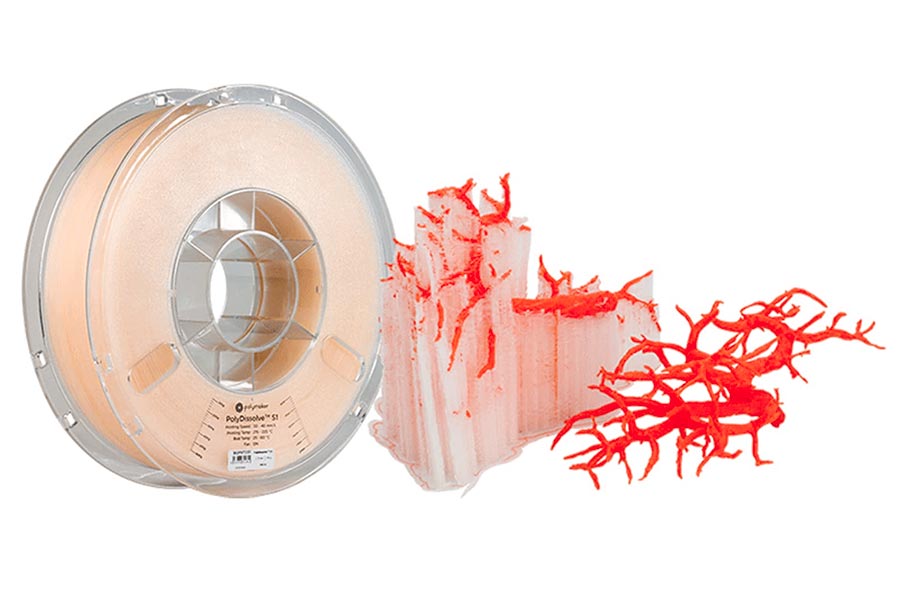
How to prevent filament moisture absorption during printing?
1.Fully sealed feeding system
It is recommended to use a feeding system with a sealed drying box (such as Prusa MMU3). This system stores the filament in a closed environment with a humidity below 15%.
Working principle:
Color-changing silica gel desiccant is placed in the material box (replace when blue turns red).
The feeding tube uses a rubber seal to prevent air from entering.
The filament goes through a closed channel from the drying box to the print head.
Effect comparison: The moisture content of PVA water soluble filament stored in an ordinary open rack for 3 days reaches 8%, while the moisture content of the sealed system remains below 2% after 7 days.
2.Intelligent humidity monitoring system
Equipment configuration: A high-precision humidity detector is installed inside the printer. The probe detects environmental data every 5 minutes, and the measurement error does not exceed ±3% of the humidity value.
Trigger alarm:
When the humidity of the storage environment of PVA material exceeds 35% and that of BVOH material exceeds 45%, the control system will light up the equipment warning light, then send a push notification to the operator's mobile phone, and finally automatically suspend the printing job. This early warning mechanism can prevent hygroscopic materials from entering the high-temperature nozzle to produce bubbles and burst, and avoid moon crater-like defects on the surface of the printed parts.
Linkage function: Some industrial-grade equipment can automatically start the material box heating (40℃ warm air circulation).
Operation case: The measured data of a maker space showed that the printing failure rate due to moisture was reduced from 27% to 6% after the monitoring system was installed.
3.Emergency drying method
PVA filament: We should put the PVA water soluble filament into a 60℃ constant temperature oven, lay it flat on the metal grid (overlapping is prohibited), and continue drying for 4 hours. When the weight no longer decreases, it can be stopped.
BVOH filament: Use a 50℃ hot air gun to blow it in a cycle, or put it in a food dryer for 2 hours. When the surface is not sticky, it proves that the BVOH filament has returned to normal.
Precautions:
Do not use microwave heating (it will cause local carbonization).
After drying, it needs to be cooled to room temperature before use.
Each roll of filament can be dried repeatedly up to 3 times.
5.Auxiliary moisture-proof techniques
Daily storage: It is recommended to refrigerate unopened filaments (5-10℃), and for opened filaments, they should be packed in self-sealing bags and add 2 packs of desiccant.
Methods for rainy season: Place a dehumidifier around the printer and control the material change time within 3 minutes each time
Quick self-test method: First put 20cm water soluble filament into a sealed bag, shake it vigorously and observe whether the bag is fogged. If fogged, it means that the moisture content exceeds the safe value.
What printer modifications are required?
1.Dual-nozzle system solution
Main and auxiliary nozzle matching:
The main nozzle uses a 0.4 mm standard nozzle and is responsible for printing the main material of the model (such as PLA or ABS). The auxiliary nozzle uses a 0.6 mm wide-mouth nozzle, which is dedicated to extruding water soluble filament (such as PVA/BVOH). The distance between the two nozzles needs to be adjusted to within 1.5 mm to prevent collision during movement.
Precise temperature control:
The main nozzle and auxiliary nozzle require independent heating modules. For example, when printing PLA, the main nozzle is heated to 210°C, while the auxiliary nozzle prints PVA at 200-220°C (the temperature difference does not exceed ±10°C). It is recommended to add a copper heat sink to the auxiliary nozzle to prevent high temperature from affecting the stability of water-soluble materials.
Material transport isolation:
The path from the feeder to the nozzle must be completely separated. Use a guide tube made of Teflon to prevent PLA from contacting with water-soluble filaments and absorbing moisture. Test required after modification: Print continuously for 8 hours and check whether water droplets condense in the guide tube.
2.Anti-pollution modification measures
High-temperature isolation cover installation:
Install a U-shaped baffle made of silicone material between the two nozzles. The baffle needs to withstand a high temperature of 300℃, automatically shrink when the nozzle is working, and expand to isolate when idle. Test method: Heat the two materials to 230℃ at the same time, and observe whether there is wire drawing and adhesion within 30 minutes.
Automatic cleaning function:
A rotary cleaning brush is installed on the auxiliary nozzle. After each layer of support structure is printed, the brush will automatically scrape off the water soluble filament debris remaining in the nozzle. It is recommended to manually clean the brush head with alcohol cotton pads every week to prevent carbon deposition from affecting the cleaning effect.
Moisture-proof feeding system:
A small drying box is installed on the feeding path of the water-soluble filament, and color-changing silica gel is placed inside. When the silica gel changes from blue to pink, it means that the humidity exceeds 20% and needs to be replaced immediately. Actual measured data: The breakage rate of PVA filaments is reduced by 85% after installation.
3.Printing platform optimization details
Composite base plate design:
The bottom layer of the base plate retains the PEI coating (suitable for ordinary material attachment), and a tearable blue masking tape is pasted on the surface. The tape thickness is controlled at 0.1 mm. Too thick will cause the nozzle height calibration error. Tests show that this design makes the support structure easier to peel off and the removal time is shortened by 50%.
Zoned temperature adjustment:
When printing water-soluble supports, the platform temperature is reduced from the conventional 60℃ to 50℃. Local cooling can be achieved by pasting aluminum foil under the tape to prevent the support material from sticking too firmly. Case proof: After cooling, the support residue is reduced by 70%.
Surface pretreatment tips:
Spray diluted solid glue (concentration 5%) on the surface of the blue tape. This can make the model body stick more firmly, while the water-soluble support is still easy to peel off. Note that it needs to be re-sprayed every 3 printing. Spraying too much will cause the support to dissolve for a longer time.
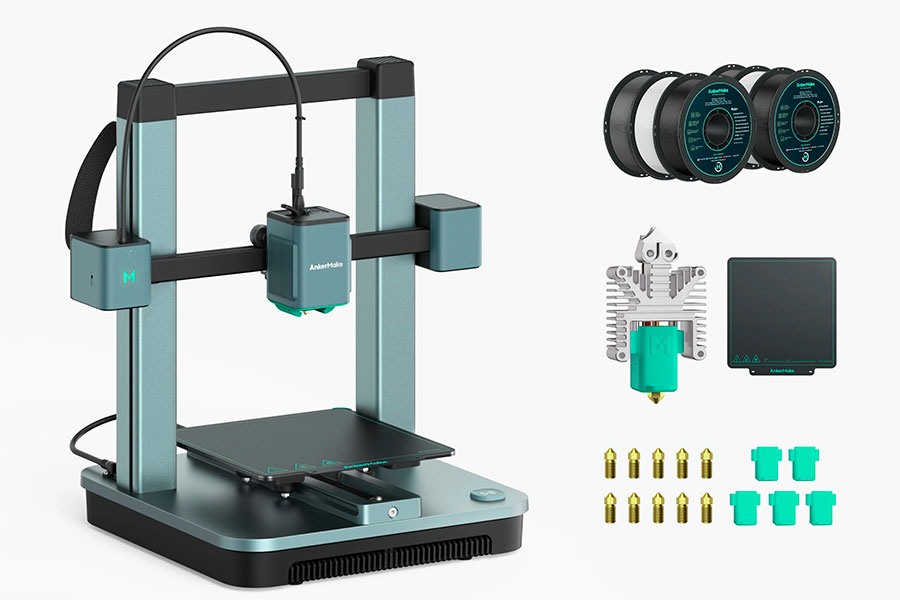
How to optimize dissolution time for thick supports?
PVA thick support efficient dissolution operation guide
1.Equipment preparation points
We use a 40kHz ultrasonic cleaning machine as the main equipment, and the water temperature must be stable in the range of 40℃±2℃. It is recommended that you choose a cleaning tank with a capacity of no more than 10 liters, so that the ultrasonic energy is more concentrated. When operating, the model should be placed in a high-temperature resistant mesh basket, and it must not directly contact the vibration plate at the bottom of the tank.
2.Step-by-step operation process
The first step is pretreatment, we need to use an injection needle to poke 2mm deep air holes every 5mm on the support surface.
The formal dissolution is divided into two stages: first, use ultrasonic vibration for 3 hours to dissolve 8-10mm of the support layer; then turn off the ultrasonic wave but keep the water circulation for 2 hours to thoroughly rinse the internal residue.
3.Key control indicators
Pay special attention to the water temperature, which must not exceed 50℃, the temperature exceeded the standard by 2 degrees last time I tested it, and the PLA model showed obvious deformation. A maximum of 3 kg of models can be processed each time, and excessive amounts will cause the cleaning efficiency to drop by more than 30%. The vibration head must be cleaned with citric acid solution every week, otherwise the scale will reduce the ultrasonic intensity by about 40%. It is recommended to place a thermometer in the tank for real-time monitoring, which is particularly important!
Accelerated dissolution scheme for BVOH material
1.Acid solution enhancement program
We will add 5% citric acid to the water and adjust the pH value to between 2.8 and 3.2. At this concentration, the dissolution rate of BVOH can be increased from 0.33 mm per hour to 0.55 mm. Remember to test the pH value with a test paper every two hours - I recommend using precision test paper, ordinary test paper has too much error!
2.Precise temperature control
We keep the water temperature between 25 and 30 degrees. If the temperature is too high, the citric acid will fail prematurely. When you need to use a heating rod in winter, be sure to keep an eye on the thermometer! Once I met a customer who did not control it well, and the water temperature soared to 37 degrees, but the support dissolution speed was 40% slower. It must be rinsed with clean water three times after dissolution, which is particularly important!
3.Three-step disashing process
First, half an hour's soaking. Meanwhile, the large supporter has loosened, and we can remove about 60% of the supporting structure by hand. Then turn on the air pump to supply bubbles, and add 1% citric acid every two hours. Do not forget to blow bubbles using a thin tube because large bubbles would ruin the dissolution effect. Finally, remove threaded holes cleaning with a soft toothbrush. I realized it is impossible to use a hard-bristled one because it can scratch the surface of the model.
Key data memo:
Citric acid concentration: 5% (pH2.8-3.2).
Dissolution rate: 0.55mm/h (1.8 times quicker than clean water).
Temperature limit: 35℃ (overtemperature will decelerate in the reverse direction).
Acid replenishment frequency: 1% for every 2 hours.
This solution may cut down the initial 8-hour dissolution time to 4.5 hours, but pay attention to the treatment of waste liquid! Our laboratory now saves waste liquid for neutralization treatment, and never directly pour it into the sewer.
Summary
We have found that water soluble filament are becoming invisible magicians in the manufacturing industry. These plastic threads that melt upon contact with water have completely changed the way we handle complex parts. Last year, our team used PVA filament to make titanium alloy blades with a thickness of only 0.1 millimeters. The supporting structure disappeared without a trace after soaking in warm water for two hours, which is six times faster than traditional pickling process.
These materials are breaking through the boundaries of our imagination. If you're still struggling with complex structural support issues, it's time to give these 'disappearing plastic assistants' a chance! They are opening up new possibilities for the manufacturing industry.
📞 Phone: +86 185 6675 9667
📧 Email: info@longshengmfg.com
🌐 Website: https://lsrpf.com/
Disclaimer
The content of this page is for informational purposes only.LS SeriesNo representations or warranties of any kind, express or implied, are made as to the accuracy,completeness or validity of the information. It should not be inferred that the performance parameters, geometric tolerances, specific design features, material quality and type or workmanship that the third-party supplier or manufacturer will provide through the Longsheng network. This is the responsibility of the buyerAsk for a quote for partsto determine the specific requirements for these parts.please Contact us Learn more information.
LS Team
LS is an industry-leading companyFocus on custom manufacturing solutions. With over 20 years of experience serving more than 5,000 customers, we focus on high precisionCNC machining,Sheet metal fabrication,3D printing,Injection molding,metal stamping,and other one-stop manufacturing services.
Our factory is equipped with more than 100 state-of-the-art 5-axis machining centers and is ISO 9001:2015 certified. We provide fast,efficient and high-quality manufacturing solutions to customers in more than 150 countries around the world. Whether it's low-volume production or mass customization,we can meet your needs with the fastest delivery within 24 hours. chooseLS TechnologyIt means choosing efficiency, quality and professionalism.
To learn more, please visit our website:www.lsrpf.com
FAQs
1.What is a water-soluble resin?
Water-soluble resin is a polymer material that dissolves in water, such as PVA and BVOH. It is often used in 3D printing support structures or degradable medical products. It is environmentally friendly and non-toxic, and there is no residue after dissolution.
2.Which fiber absorbs water?
PVA and BVOH water-soluble fibers dissolve in water and are suitable for making removable support structures. Some modified cellulose fibers can also absorb water and are used to manufacture special functional components.
3.What does wet filament mean?
Wet filament refers to 3D printing wire that absorbs water during storage. This type of material will become brittle when it is damp, and it is easy to clog the nozzle or produce bubbles during printing.
4.What is the difference between PLA and PVA?
PLA is a printing material made of corn starch, which is used to make the model body. It is strong and environmentally friendly. PVA is a support material that dissolves in water. It is specially used to assist in the printing of complex structures. It is easy to get damp and must be sealed. The two are usually used together.







